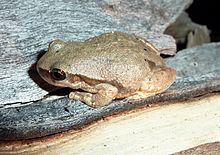Desert tree frog
species of amphibian
The desert tree frog, naked tree frog, seagull frog, red tree frog, little red tree frog or brown tree frog (Litoria rubella) is a frog from Papua New Guinea, Indonesia and northern Australia.[3][4][5]
| Desert tree frog | |
|---|---|

| |
| Scientific classification | |
| Domain: | Eukaryota |
| Kingdom: | Animalia |
| Phylum: | Chordata |
| Class: | Amphibia |
| Order: | Anura |
| Family: | Pelodryadidae |
| Genus: | Litoria |
| Species: | L. rubella
|
| Binomial name | |
| Litoria rubella Gray, 1842
| |

| |
| Desert tree frog distribution | |
| Synonyms[2] | |
| |
The male adult frogs is about 31 to 35 mm long from nose to rear end and females are 33 to 37 mm long. They are light brown in color with darker brown spots and a dark brown stripe down each side of its body. They have yellow colouring on their legs.[3]
This frog lives in many different kinds of places, for example swamps and streams and ditches. It often lives near human houses, where it can climb into pipes.[3]
They lay eggs on the surface of non-moving water, 30–300 eggs at a time. The tadpoles become frogs in two weeks.[4]
References
change- ↑ Djoko Iskandar; Mumpuni; Jean-Marc Hero; Dale Roberts; Paul Horner; Richard Retallick; Ed Meyer; John Clarke; Stephen Richards; Fred Parker (2004). "Litoria rubella". IUCN Red List of Threatened Species. 2004: e.T41110A10400269. doi:10.2305/IUCN.UK.2004.RLTS.T41110A10400269.en.
- ↑ "Litoria rubella (Gray, 1842)". Amphibian Species of the World 6.0, an Online Reference. American Museum of Natural History. Retrieved October 20, 2020.
- ↑ 3.0 3.1 3.2 "Litoria rubella (Desert Tree Frog)". FrogWatch Southern Australia. Retrieved July 6, 2020.
- ↑ 4.0 4.1 J-M Hero; et al. (April 5, 2002). "Litoria rubella: Desert Tree Frog". Amphibiaweb. Retrieved July 6, 2020.
- ↑ Djoko Iskandar; Mumpuni; Jean-Marc Hero; Dale Roberts; Paul Horner; Richard Retallick; Ed Meyer; John Clarke; Stephen Richards; Fred Parker (2004). "Desert Tree Frog: Litoria rubella". 2004. The IUCN Red List of Threatened Species: e.T41110A10400269. doi:10.2305/IUCN.UK.2004.RLTS.T41110A10400269.en. Retrieved July 6, 2020.
{{cite journal}}: Cite journal requires|journal=(help)
